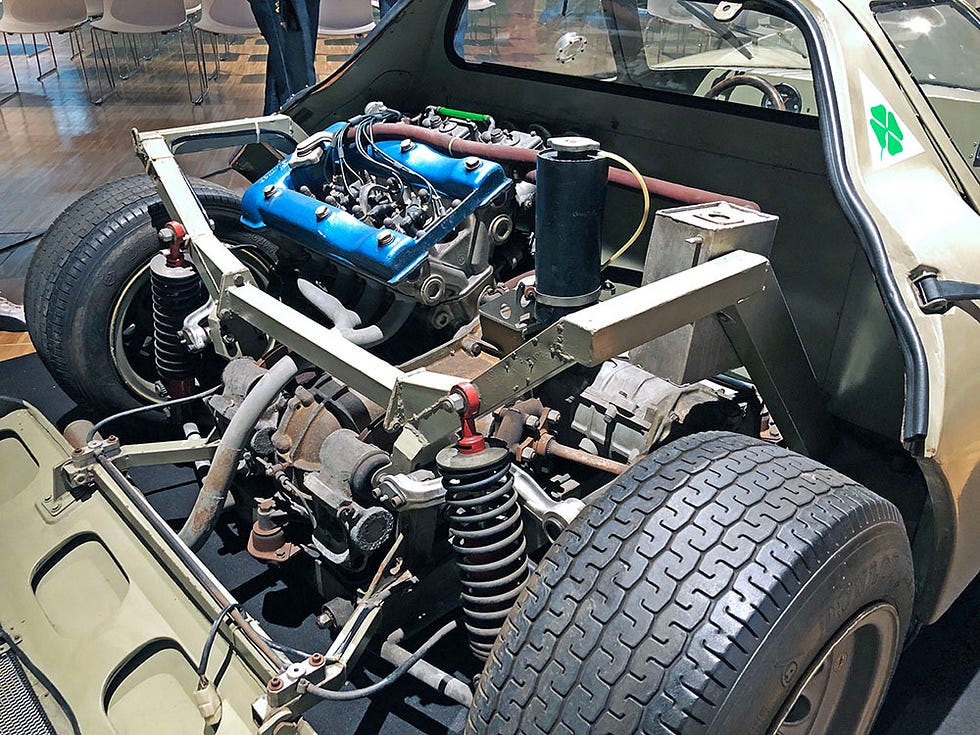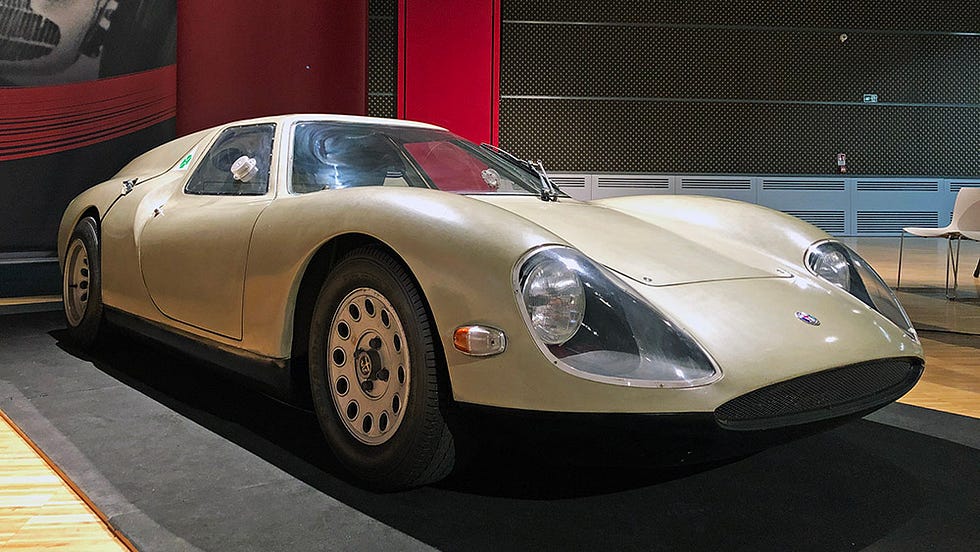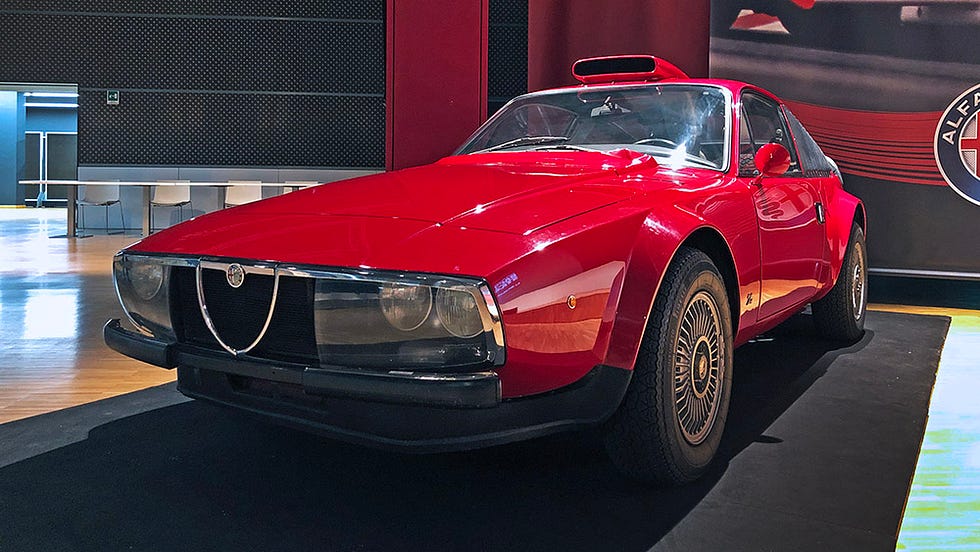Scarabeo: The Weird, Secret Alfa Romeo Project You’ve Never Heard Of
Scarabeo is the Italian word for “beetle,” but for a few knowledgeable Alfa Romeo fans, it is also the name of one of the most tantalizing “might have been” chapters in the Marque’s long history.
スカラベオ。知られざるアルファロメオの秘密プロジェクト
スカラベオとはイタリア語で「甲虫」を意味する言葉だが、アルファロメオの長い歴史の中で「あったかもしれない」と思わせるエピソードを持つ、一部の知識豊富なファンにとってはたまらない名前である。

The 1966 OSI Scarabeo show car (picture from Wheelsage.org)
1966年のOSIスカラベオのショーカー(画像はWheelsage.orgより引用)
Our story begins in February of 1966, less than a month after Alfa’s experimental department had begrudgingly surrendered the development of the 33 sports prototype to Autodelta, the racing department of Alfa Romeo headed by Carlo Chiti.
But the Portello’s proud engineers, headed by the great Orazio Satta, had racing in their blood and weren’t at all happy to leave all racing cars development to Chiti’s outfit, even if that’s precisely how Alfa Romeo’s president Giuseppe Luraghi wanted things to go.
“Losing” the 33 proved a particularly bitter pill to swallow for its creator Giuseppe Busso, who began working on a new racing car project in the hope that, by sticking within an inferior category and with a significantly cheaper car, he may keep this new program from going off to Autodelta.
Similarly to what happened with the 33 sports prototype, the new project received a type “105” code (105.56, to be precise) even though it very obviously wasn’t a direct derivative of the Giulia sedan.
1966年2月、アルファの実験部門が33スポーツプロトタイプの開発をカルロ・キティ率いるアルファロメオのレース部門であるオートデルタに嫌々ながら委ねてから1ヵ月も経たないうちに、私たちの物語は始まる。
しかし、偉大なるオラツィオ・サッタを筆頭とするポルテーロの誇り高きエンジニアたちは、たとえアルファロメオのジュゼッペ・ルラギ社長の意向であっても、レーシングカーの開発をすべてチチの会社に任せることを快く思ってはいなかった。
「33の生みの親であるジュゼッペ・ブッソは、33を失ったことを苦々しく思い、劣悪なカテゴリーで、より安価なマシンを作ることで、アウトデルタに移籍しないよう新しいレーシングカーのプロジェクトに着手した。
スポーツプロトタイプの33と同様、ジュリア・セダンの直接の派生モデルではないにもかかわらず、この新しいプロジェクトにはタイプ「105」(正確には105.56)のコードが与えられた。
The design
Busso started from the advanced aluminum H-shaped frame he devised for the 33, which housed the fuel in a rubber bladder tank packaged inside the thick chassis members. However, to simplify construction and reduce costs, he did away with the 33’s complex magnesium castings at the front and at the rear, where a Giulia GTA engine was mounted transversely in place of the 33’s longitudinal V8.
The 1.6 liters, dual ignition GTA engine was mated to a standard Giulia gearbox, which sent power to the centrally mounted differential casing via a short, oblique propshaft: a somewhat crude solution imposed by the need to keep costs down.
デザイン
ブッソは、33のために考案した先進のアルミ製H型フレームをベースに、燃料をゴム製のブラダータンクに入れ、厚いシャシー部材の中に納めることから始めた。しかし、構造の簡素化とコストダウンのため、33の複雑なマグネシウム鋳造をフロントとリアから排除し、33の縦置きV8エンジンに代えてジュリアGTAエンジンを横置きで搭載した。
1.6リッターのデュアルイグニッションGTAエンジンは、標準のジュリア・ギアボックスと組み合わされ、中央に取り付けられたデフ・ケースに、短い斜めのプロペラシャフトを介してパワーを送るという、コスト削減の必要性によるやや雑なソリューションであった。

The engine compartment of the third Scarabeo prototype (picture from the Author)
スカラベオプロトタイプ3号機のエンジンルーム(著者撮影)
Fitting the engine transversely made for a shorter wheelbase and placed the driver closer to the rear wheels than the 33.
This created a remarkably compact and low-slung car that was a promising replacement for the Giulia TZ on the racetrack and an ideal base for a jaw-dropping show car.
エンジンを横置きにすることでホイールベースを短くし、33型よりもドライバーを後輪に近づけることができた。
このため、驚くほどコンパクトで低い車高が実現し、レース場ではジュリアTZの代役として期待され、顎の高いショーカーのベースとして理想的な車となった。
The OSI Scarabeo
The Turinese firm OSI (an acronym for Officina Stampaggi Industriali) may not enjoy the same recognition as Bertone or Pininfarina, yet in the mid-60s was a well-established company whose well-staffed styling studio was ideal for giving Busso’s racing car a look to die for.
Penned by Sergio Sartorelli and exhibited at the Paris and Turin motor shows during the autumn of 1966, the OSI Scarabeo stirred the imagination of critics and the public alike, including president Luraghi, who instructed Busso to build a functional prototype for testing, as the show car was actually engineless.
There’s no way of knowing exactly why the prototype was named “Scarabeo” and who chose it, but it most likely stems from the car’s rather striking shape and diminutive size.
OSIスカラベオ
トリノのOSI(Officina Stampaggi Industrialiの頭文字)は、ベルトーネやピニンファリーナのような知名度はないが、60年代半ばには老舗のスタイリングスタジオとして、ブッソのレーシングカーに理想的なルックスを与えていた。
1966年秋、パリとトリノのモーターショーに出品されたOSIスカラベオは、ルラギ社長以下、評論家、一般大衆の想像力をかきたて、ブッソはショーカーにはエンジンがないため、テスト用に機能的なプロトタイプを製作するように指示した。
このプロトタイプがなぜ「スカラベオ」と名づけられたのか、また誰が名づけたのかはわからないが、おそらくはその印象的なフォルムと小さなサイズに由来しているのだろう。
Development (or lack thereof)
Two “Scarabeo” running prototypes were ultimately built: one whose body only consisted of a rudimentary front skin, which ran at the Balocco proving ground in 1968, and a complete car sporting a much more conventional design than the original show prototype.
開発経緯
1968年にバロッコ試験場で走行したフロントスキンのみのプロトタイプと、ショープロトタイプよりもはるかにオーソドックスなデザインのコンプリートカーの2台の「スカラベオ」走行プロトタイプが製作された。

The Scarabeo in Alfa Romeo’s museum (picture from the Author)
アルファロメオのミュージアムにある「スカラベオ」(筆者撮影)
Both survive in the Alfa Romeo museum’s collection, while the original, non-functional motor show model found its way across the Atlantic and has yet to be seen since. However, it’s believed to have survived and apparently will be restored and equipped with a period-correct drivetrain.
However, not only Busso’s hopes to keep his new “baby” away from Carlo Chiti and Autodelta were ultimately dashed, but the whole project ended up pretty much dead on arrival.
With Autodelta’s resources already overstretched between dominating touring car racing with the Giulia GTA and developing the three-liter version of the 33 sports prototypes, the Scarabeo project languished and ultimately fizzled out entirely in 1969.
2台ともアルファロメオのミュージアムに収蔵されているが、オリジナルの非機能的なモーターショーモデルは大西洋を渡ってしまい、それ以来、まだ見ることができない。しかし、このモデルは現存していると考えられており、どうやらレストアされて当時のドライブトレインを搭載することになりそうだ。
しかし、カルロ・キティとアウトデルタからこのクルマを引き離したいというブッソの希望は、最終的に打ち砕かれたばかりか、プロジェクト全体が立ち行かなくなった。
ジュリアGTAでツーリングカーレースを制覇し、33スポーツプロトタイプの3リッター版を開発するなど、アウトデルタのリソースはすでに手いっぱいだったため、スカラベオのプロジェクトは停滞し、1969年に完全に頓挫してしまった。
Encore
But Busso resurrected his idea of a small mid-engined sports coupé made from existing Alfa components around 1972, probably with an eye to the growing popularity of rallies.
アンコール
しかし、ブッソは1972年頃、ラリー人気の高まりを意識してか、既存のアルファの部品を使った小型ミッドエンジン・スポーツクーペのアイデアを復活させる。

The “Scarabeo II” (picture from the Author)
スカラベオII」(画像は筆者提供)
However, instead of a bespoke racing chassis, the new car’s structure would have been a traditional steel unibody built from a modified Alfetta floorpan and was therefore given a type “116” code (116.21, to be precise) like any other Alfetta derivative.
What this new project has in common with the original Scarabeo is the transverse mid-engined layout featuring the weird oblique propshaft to send power from the standard Giulia gearbox to the differential.
In fact, the engine and transmission were regular production items lifted straight from the 2000 GTV parts bin, except for a bespoke oil sump to clear the De Dion rear suspension.
しかし、特注のレーシング・シャシーではなく、アルフェッタのフロアパンを改造した伝統的なスチール製ユニボディであるため、他のアルフェッタ派生車種と同様にタイプ「116」コード(正確には116.21)が与えられていた。
この新プロジェクトが初代スカラベオと共通しているのは、横置きミッドエンジンレイアウトで、ジュリア標準のギアボックスからデフにパワーを送るための奇妙な斜めのプロペラシャフトが採用されていることだ。
ただし、デ・ディオンのリア・サスペンションをクリアするために特注のオイル・サンプが装着されているのみで、エンジンやトランスミッションは2000年型GTVの部品箱からそのまま持ち込まれたレギュラー・アイテムである。

The engine bay of the “Scarabeo II” (picture from the Author)
スカラベオII」のエンジンルーム(筆者撮影)
With no resources available for a new and original design for the so-called “Scarabeo II” prototype, Busso resorted to having a modified Junior Zagato body grafted onto the Alfetta floorpan. By the way, the giant air scoop on the roof, which led some to call this prototype “periscopica,” is functional and feeds directly into the engine’s air box.
The prototype was built in 1973, but just as it happened for the original Scarabeo, the project had already lost momentum by the time it hit Balocco’s tarmac in early 1974: in the aftermath of the oil crisis and with Alfa entering a period of turmoil from the shop floor up to the boardroom, the timing simply couldn’t have been worse for such a project.
Thankfully, though, the unique prototype was stored rather than scrapped, and following a conservative restoration in the mid-80s, it’s been preserved in the Alfa Romeo museum’s collection ever since.
スカラベオIIと呼ばれるプロトタイプは、オリジナルなデザインにする資源がなかったため、ジュニア・ザガートのボディを改造してアルフェッタのフロアパンに接ぎ木したものであった。ちなみに、このプロトタイプを「ペリスコピカ」と呼ぶ人もいるルーフ上の巨大なエアスクープは、エンジンのエアボックスに直結している機能的なものである。
1973年にプロトタイプが製作されたが、初代スカラベオがそうであったように、1974年初頭のバロッコではすでにプロジェクトの勢いは失われていた。オイルショックの余波を受け、アルファは現場から役員に至るまで混乱の時代に突入しており、このプロジェクトにとって最悪のタイミングであったといえる。
しかし、幸いなことに、このユニークなプロトタイプはスクラップされることなく保管され、80年代半ばに慎重なレストアを経て、以来、アルファロメオ・ミュージアムのコレクションとして保存されてきた。
Epilogue
Alfa Romeo would only produce a mid-engined car well into the current Millennium, with the arrival of the gorgeous 4C in 2013. But that’s definitely a story for another time…
エピローグ
アルファロメオがミッドエンジン車を生産するのは、2013年に登場したゴージャスな4Cを最後に、現在のミレニアムに入るまでとなる。しかし、それはまた別の機会にお話ししましょう。
引用サイト:https://medium.com/roadster-life/scarabeo-the-weird-secret-alfa-romeo-project-youve-never-heard-of-a3e83b0f69dc
~DeepLで翻訳しました。~














